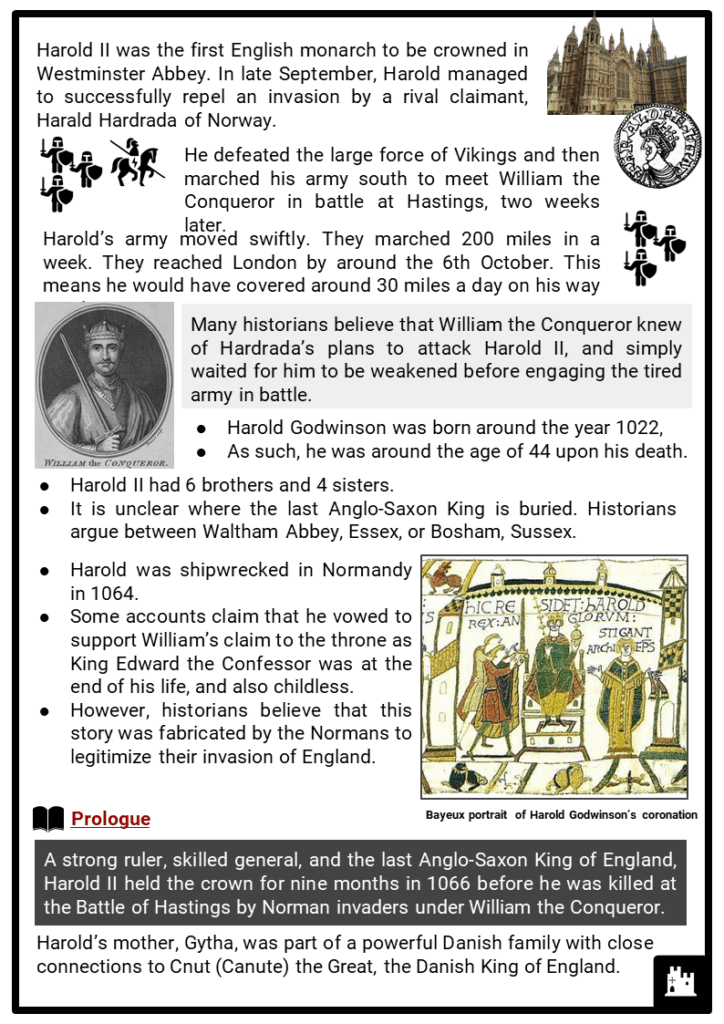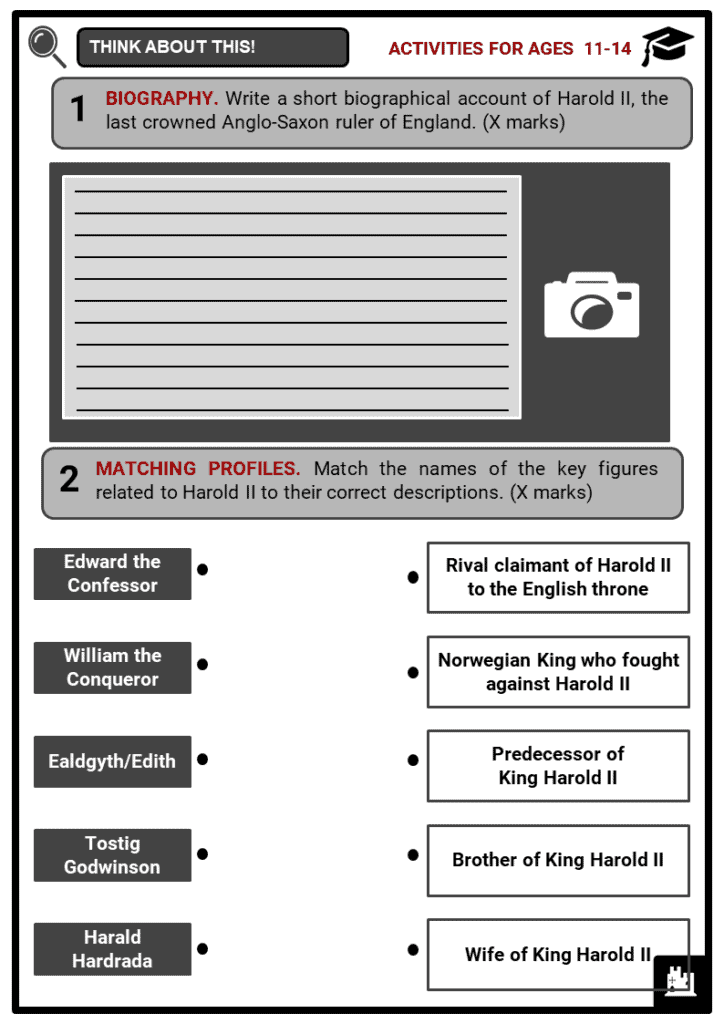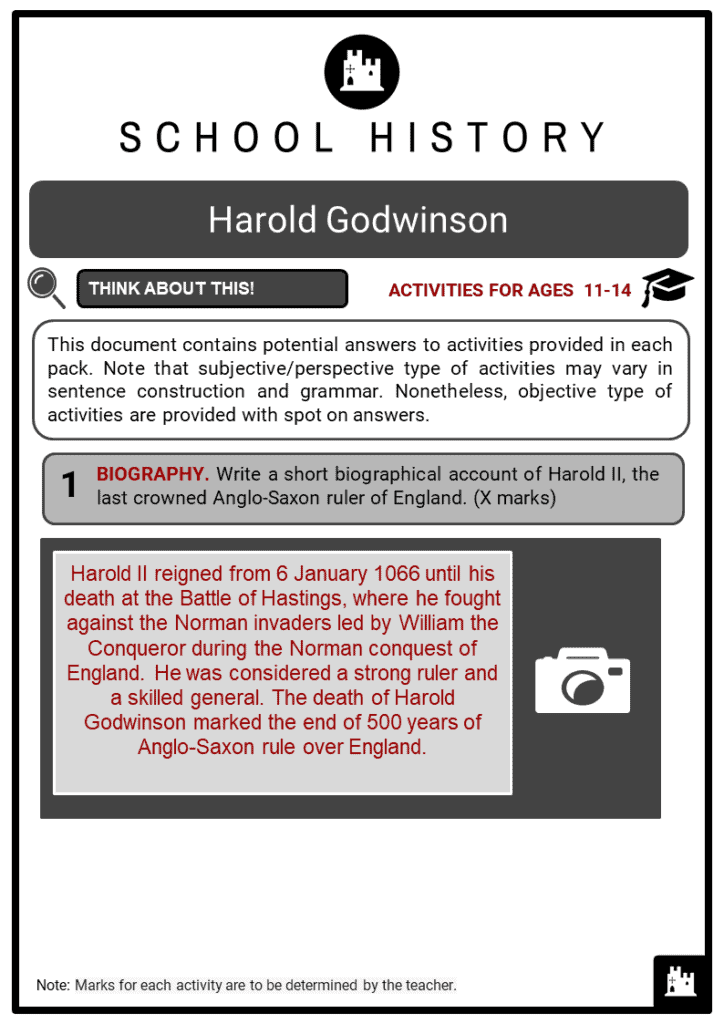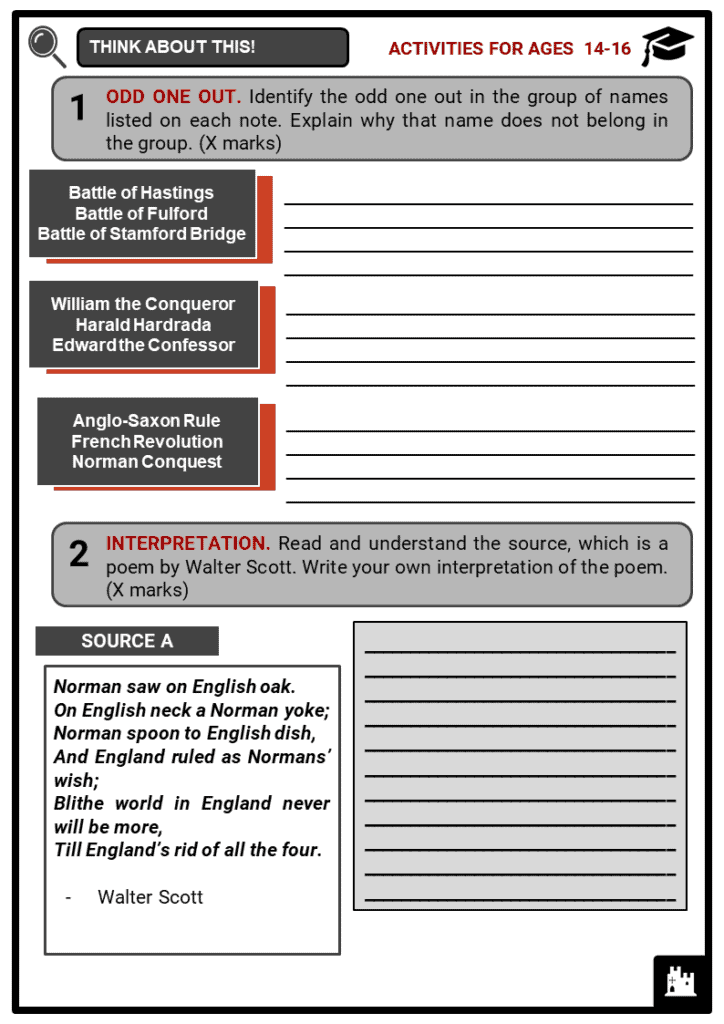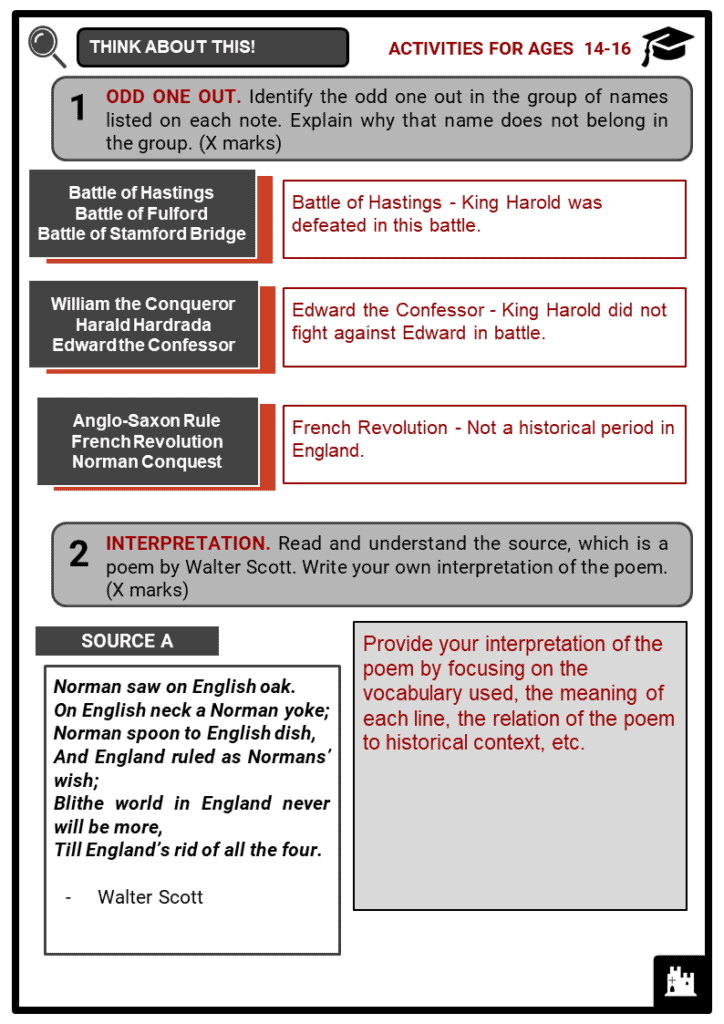Download Harold Godwinson Worksheets
Do you want to save dozens of hours in time? Get your evenings and weekends back? Be able to teach Harold Godwinson to your students?
Our worksheet bundle includes a fact file and printable worksheets and student activities. Perfect for both the classroom and homeschooling!
Table of Contents
Add a header to begin generating the table of contents
Summary
- Who is Harold Godwinson?
- Key events during Harold Godwinson’s rule
- Key figures related to Harold Godwinson
Key Facts And Information
Let’s know more about Harold Godwinson!
- Harold Godwinson, also referred to as Harold II, was the last crowned Anglo-Saxon King of England.
- Harold II reigned from 6 January 1066 until his death at the Battle of Hastings on 14 October 1066, where he fought against the Norman invaders led by William the Conqueror during the Norman conquest of England. The death of Harold Godwinson marked the end of 500 years of Anglo-Saxon rule over England. Harold II was a powerful earl and a member of a prominent Anglo-Saxon family with ties to Cnut the Great – a king who ruled Denmark, England, and Norway – often referred to as the North Sea Empire. Upon the death of his brother-in-law, King Edward the Confessor, on January 5, 1066, the Witenagemot
convened and chose Harold to succeed. - Harold II was the first English monarch to be crowned in Westminster Abbey. In late September, Harold managed to successfully repel an invasion by a rival claimant, Harald Hardrada of Norway.
- He defeated the large force of Vikings and then marched his army south to meet William the Conqueror in battle at Hastings, two weeks later.
- Harold’s army moved swiftly. They marched 200 miles in a week. They reached London by around the 6th October. This means he would have covered around 30 miles a day on his way south.
- Many historians believe that William the Conqueror knew of Hardrada’s plans to attack Harold II, and simply waited for him to be weakened before engaging the tired army in battle.
- Harold Godwinson was born around the year 1022,
- As such, he was around the age of 44 upon his death.
- Harold II had 6 brothers and 4 sisters.
- It is unclear where the last Anglo-Saxon King is buried. Historians argue between Waltham Abbey, Essex, or Bosham, Sussex.
- Harold was shipwrecked in Normandy in 1064.
- Some accounts claim that he vowed to support William’s claim to the throne as King Edward the Confessor was at the end of his life, and also childless.
- However, historians believe that this story was fabricated by the Normans to legitimize their invasion of England.
Prologue
- A strong ruler, skilled general, and the last Anglo-Saxon King of England, Harold II held the crown for nine months in 1066 before he was killed at the Battle of Hastings by Norman invaders under William the Conqueror.
- Harold’s mother, Gytha, was part of a powerful Danish family with close connections to Cnut (Canute) the Great, the Danish King of England.
- Harold’s father, Godwine, Earl of Wessex and Kent, was an important supporter of the King.
- Though Godwine was an ally of the Anglo-Danish line, he supported the ascension of Edward the Confessor (1042-66) as King.
- Edward was a member of the former English royal family, and Godwine supported him after the death of Canute’s successor.
- Though Edward obtained the throne, Godwine was the dominant figure in the King’s early reign, more powerful than the king himself.
- Around the year 1044, Godwine obtained for his son Harold the earldom of East Anglia, Essex, Cambridgeshire, and Huntingdonshire, and in 1045, the King, Edward, married Edith, Godwine's daughter.
- Things changed, however, as in 1051, Godwine refused to obey a royal command, namely, to punish the people of a town friendly to him.
- Both sides rallied their troops, but Godwine’s rebellion collapsed when many powerful nobles supported King Edward.
- Godwine and his sons were thus banished for defying the royal authority, and his daughter Edith (the King’s wife) was sent to a convent.
- In 1052, Harold invaded England and forced the King to restore his father and his family to their previous positions.
Harold Godwinson
- Born into the powerful Godwinson family around 1023 CE, Harold was destined to rule and uphold the family name.
- Harold’s father, Godwine, was the Earl of Wessex, and one of the richest men in England.
- Harold’s mother, on the other hand, was Gytha of the Thorgils family.
- Through her brother Ulaf, she was connected with the royal house of Denmark.
- In 1045 CE, Harold was made the earl of East Anglia, then part of his father’s huge estates.
- When his father died, Harold became the Earl of Wessex, in 1053 CE, though he had to give up East Anglia, in order for the King, Edward the Confessor, to have a more balanced distribution of power amongst his earls.
- The 1050s CE had seen the Godwinson family in a bitter rivalry with the King, which at one point saw Harold temporarily seek refuge in Ireland (1051-2 CE).
- This rivalry was so great that not even the fact that Harold’s sister was married to the King could prevent it.
- The Godwinsons proved too powerful and their followers were fiercely loyal.
- Harold proved himself a useful leader for the King, building his reputation on successful military conquests such as the attack on Gruffydd ap Llywelyn, King of Wales in 1063-4 CE.
- Harold was assisted by his brother Tostig, Earl of Northumbria in Wales, and the two earls launched a land and sea attack in the autumn of 1063 CE, driving Gruffydd into exile.
- The Welsh were very concerned about Harold’s might, and as such, they caught up with their King, killed him, and presented his head to Harold.
- This campaign brought great credit to Harold, so much so that he was widely applauded as the subregulus (under-king) and dux Anglorum (commander-in-chief of the English).
- Another one of Harold’s accomplishments came when he sorted out the problems in the north of England, interestingly caused by his brother Tostig.
- Tostig’s harsh rule and over-taxation had caused a serious revolt in Northumbria in 1065 CE.
- He was ultimately stripped of his power and banished out of harm’s way to Flanders while Harold managed to placate the Northumbrian nobles by visiting the area in person.
- Some rumors stated that Harold actually engineered the whole scenario to gain even greater favour with King Edward and promote himself as the King's chosen heir.
- Harold also took Ealdgyth as his wife in 1065 CE.
- She was the former wife of Gruffydd.
- This union was most likely intended to cement both loyalties in Wales and Northumbria since Ealdgyth was the sister of the earls of Northumbria, Mercia, and northern England.
- Harold also had a long-term partner, Edith Swan-Neck, with whom he had five children.
Harold in Normandy
- Harold was crowned King on the 6th January 1066 CE, following the death of Edward the Confessor, who died childless. Harold had obtained the crown in dubious circumstances, even though the King himself chose him as his successor on his deathbed. In truth, there weren’t many other viable candidates.
- One possible claimant was Edgar Ætheling, son of Edward the Exile, and the great-nephew of Edward the Confessor, but he was too young and so he was sidelined by Harold, most likely with the support of the other English earls.
- The rapidity with which Harold had himself crowned was unprecedented and smacked of getting the deed done before too much argument broke out amongst rival claimants. One event, two years before the coronation of Harold, may explain this hastiness.
- In the spring of 1064 CE, Harold was (possibly) sent on an unknown mission by Edward to the court of William, Duke of Normandy.
- Some speculate that the purpose was to inform William that he was nominated as the successor of the English throne and that Harold had sworn fealty to him.
- In an alternative version of the event, Harold never went to Normandy at all or was merely blown off course and landed in France by accident.
- He was captured by Count Guy of Ponthieu and released thanks to a payment from William, who then hosted Harold in his own court (he was possibly kept as a prisoner).
- William used Harold in the Normans’ battles with Duke Conan of Brittany where Harold fought bravely and earned the respect of his “captors”. These events are vividly depicted in the Bayeux Tapestry, made between 1067 and 1079 CE. Harold was knighted by William for his efforts, according
to the Bayeux Tapestry. - It was perhaps a condition of Harold’s release from William’s grasp that he had to promise William the throne of England or at least accept vassal status. This is at least the version presented by Norman chronicles.
- Another take on these events is presented in the Anglo-Saxon Chronicle. It states that Harold only visited William’s court to secure the release of some captured compatriots.
- The pro-Anglo-Saxon camp suggests that even if Harold had promised to act as William’s agent in England, swearing loyalty to him, being a captive at the time, it was done under duress and so invalid.
- Regardless of what version of the story is true, it is clear that William was prepared to use force and wrest the crown from Harold’s head and take England for the Normans.
Battle of Stamford Bridge
- The most immediate threat to Harold’s kingdom was not from William, though, but from Harald Hardrada, the King of Norway.
- Hardrada believed that he was the rightful ruler of Denmark, a kingdom that had long claimed sovereignty over large parts of England and which had been, since 950 CE, receiving regular payments from English kings to stop their further expansion.
- Hardrada’s claim was weak as he had already failed to take the Danish throne for himself, though he was prepared to press
and claim the English throne by force. He amassed an invasion
fleet that sailed to England in September 1066 CE. - Hardrada’s forces comprised of 300 ships and his army was around 12,000 men. He was helped by Tostig, Harold’s exiled brother, who saw Hardrada as an opportunity to wrest the throne from his brother. He pledged a small fleet of around 12 ships to Hardrada’s forces, and Tostig himself was also present.
- The two fleets sailed south and soon the first battle ensued at Fulford Gate, a location near York.
- There, on the 20th September, an Anglo-Saxon army led by Eadwine (Earl of Mercia) and Morcar (Earl of Northumbria) clashed with Hardrada’s army.
- Hardrada was victorious, however Harold was on his way with a second army which included his elite force of up to 3,000 housecarls (huscarls – professional armoured troops).
- On the 25th September, Harold’s army met Hardrada’s forces at Stamford Bridge, a wide meadow somewhere east of the River Derwent.
- Hardrada's men were caught by surprise. They were expecting a negotiation to take place since they held hostages from York after the city's capitulation the day before.
- Thus, they were without their mail armour coats and the battle was concluded in less than a day, with both Hardrada and Tostig being swiftly killed.
- The Anglo-Saxon Chronicle states that there were few survivors, enough to perhaps fill just around 24 ships.
- Even though this was a great victory, news reached Harold of William’s army landing in the south of England, and thus there was no time for celebration.
Battle of Hastings
- William had amassed a fleet on the northern coast of France throughout the summer of 1066 CE.
- Some Norman sources stated that William had around 776 ships at his disposal, but these numbers are likely exaggerated.
- The exact force remains unknown, however most historians suggest a figure of around 8,000 men, which included 1,000-2,000 cavalry.
- On the 26th September, William landed with his army at Pevensey in Sussex, southern England, where a good harbour was present and an old Roman fort was nearby, which was refortified by William.
- Harold arrived in London on 6th October and mustered his army. They gathered at Caldbec Hill, 13 km / 8 miles north of Hastings.
- Harold’s force included his elite housecarls and the general levy (fyrd – poorly trained troops supplied by each shire of the kingdom).
- However, many medieval writers stated that Harold mobilised too soon.
- Some believe that he was enticed to do so since William was ravaging through territories where Harold’s estates lay.
- The two armies met on 14th October 1066.
- Harold and his army took up positions on a low rise, “hammerhead ridge”, which was protected on the sides by woods and in front by a stream and marshy ground.
- Most of the Anglo-Saxon army was on foot, and they formed a “shield-wall” and, bristling with spears, axes, and swords, they prepared to face the enemy. They had few archers and almost no cavalry.
- William’s army took up positions to the south of the ridge in three infantry divisions: Bretons, Normans, and French – each with a line of archers and crossbowmen in front and the cavalry held in reserve at the rear.
- The battle started with a barrage of arrows from William’s side, but the Anglo-Saxons responded by hurling stone axes at the infantry as it tried to climb the ridge. Though the Norman cavalry was also advancing, they were hampered by the terrain, and they were also repelled by the Saxon shield wall.
- At one dramatic moment, the Normans retreated as they believed that William was struck down.
- He was however unhurt, and he raised his visor and rode amongst his men to show that he was still alive and in control of the situation.
- This may have turned the tide of the battle as many armies in the Middle Ages would desert the field once their commander had fallen.
- Some Anglo-Saxons, encouraged by the retreat of the Norman cavalry, raced after them down the hill.
- However, once they reached the lower grounds and lost their formation, they were cut down by the horsemen as they reverse-charged.
- William observed this and he feigned two more charges and retreats up to the ridge and back again. Both times the Anglo-Saxons were lured and slaughtered since the flatter ground was more suitable for the horses.
Death of King Harold
- The battle went on for many hours, an unusually long time for a medieval battle. However, the Norman cavalry was superior to the Anglo-Saxon infantry, and they were gradually winning, especially since the Anglo-Saxon numbers were reduced and thus they were unable to defend the ridge.
- In a final effort, Harold, his brothers Gyrth and Leofwine, and other Saxon leaders, rode up in a final cavalry charge, however, they were all killed.
- It is said that an arrow struck Harold in his eye, then he was knocked over by the enemy cavalry, and finally, he was hacked to pieces by Norman swords as he lay on the ground. The contemporary and later sources are all conflicting on exactly how Harold may have died.
Harold’s Tomb – Aftermath
- Harold’s death marked the end of 500 years of Saxon rule.
- William the Conqueror, as he became known, was crowned
William I, King of England on Christmas Day 1066, at Westminster Abbey. - He struggled for five years, winning battles against rebels in the north of England and building Norman motte and baileys everywhere, which consolidated his new realm.
- The fate of Harold’s body is unknown.
- Some legends say that his mother, Gytha, offered her dead son’s weight in gold to receive his body and give him a decent burial but she was refused by William.
- Another legend states that Harold actually survived the battle and lived into old age but such stories and the mystery regarding the fate of the last Anglo-Saxon King are probably exactly what William wished for. There was no grave for rebels to rally around, meaning that the Normans were here to stay.


